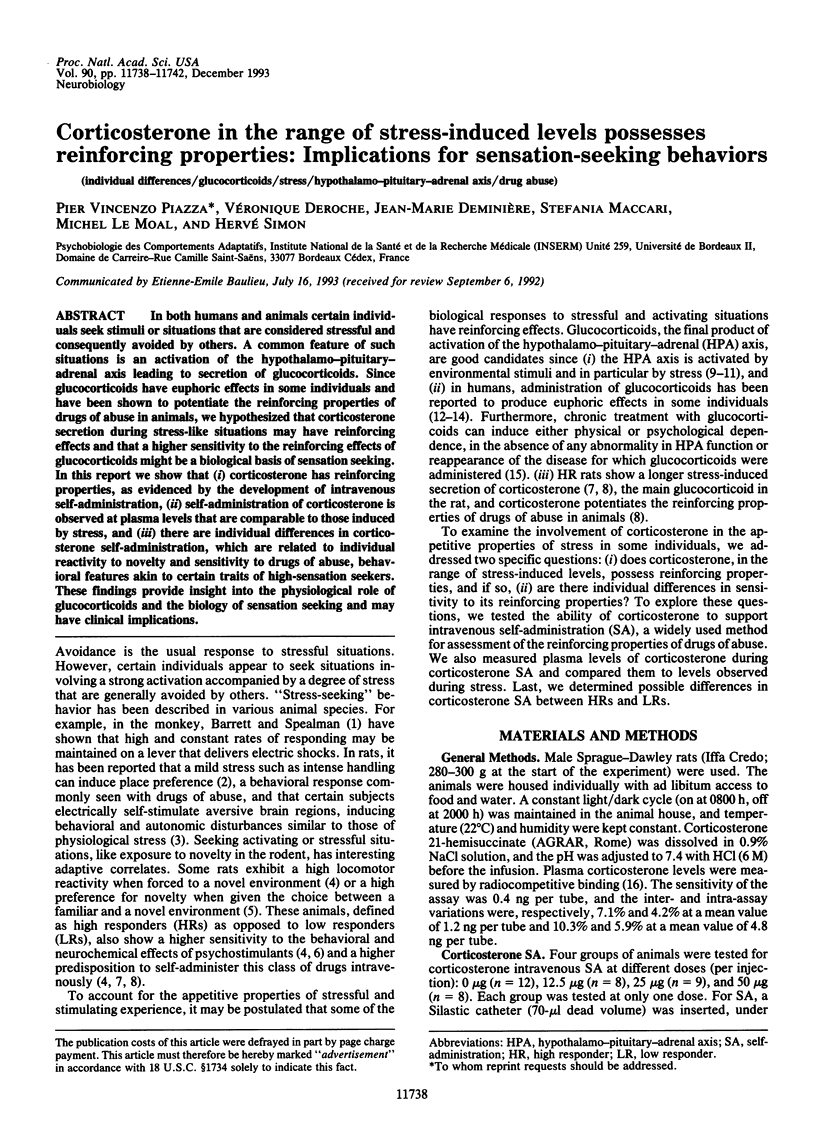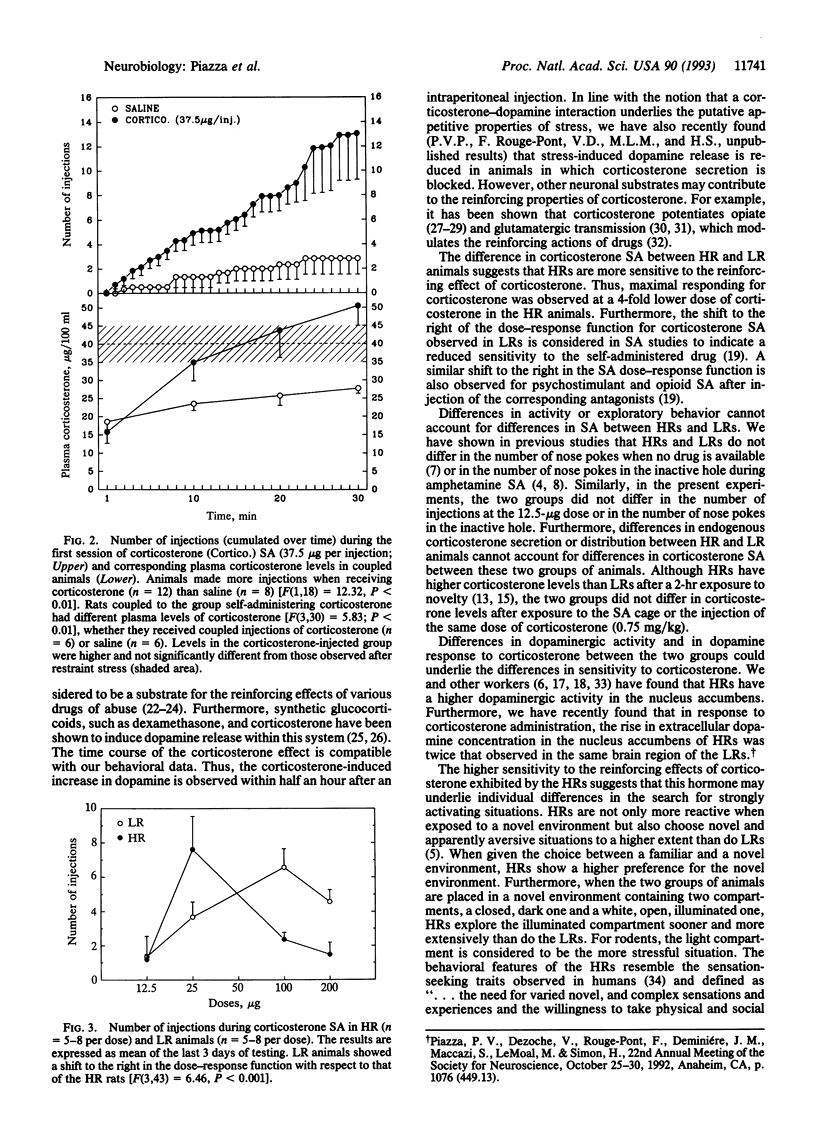Abstract
In both humans and animals certain individuals seek stimuli or situations that are considered stressful and consequently avoided by others. A common feature of such situations is an activation of the hypothalamo-pituitary-adrenal axis leading to secretion of glucocorticoids. Since glucocorticoids have euphoric effects in some individuals and have been shown to potentiate the reinforcing properties of drugs of abuse in animals, we hypothesized that corticosterone secretion during stress-like situations may have reinforcing effects and that a higher sensitivity to the reinforcing effects of glucocorticoids might be a biological basis of sensation seeking. In this report we show that (i) corticosterone has reinforcing properties, as evidenced by the development of intravenous self-administration, (ii) self-administration of corticosterone is observed at plasma levels that are comparable to those induced by stress, and (iii) there are individual differences in corticosterone self-administration, which are related to individual reactivity to novelty and sensitivity to drugs of abuse, behavioral features akin to certain traits of high-sensation seekers. These findings provide insight into the physiological role of glucocorticoids and the biology of sensation seeking and may have clinical implications.
Full text
PDF




Selected References
These references are in PubMed. This may not be the complete list of references from this article.
- Barrett J. E., Spealman R. D. Behavior simultaneously maintained by both presentation and termination of noxious stimuli. J Exp Anal Behav. 1978 May;29(3):375–383. doi: 10.1901/jeab.1978.29-375. [DOI] [PMC free article] [PubMed] [Google Scholar]
- Cazala P., Bendani T., Zielinski A. Self-stimulation of an 'aversive' brain structure: the mesencephalic central gray area. Brain Res. 1985 Feb 18;327(1-2):53–60. doi: 10.1016/0006-8993(85)91498-2. [DOI] [PubMed] [Google Scholar]
- Chao H. M., McEwen B. S. Glucocorticoid regulation of neuropeptide mRNAs in the rat striatum. Brain Res Mol Brain Res. 1991 Mar;9(4):307–311. doi: 10.1016/0169-328x(91)90077-b. [DOI] [PubMed] [Google Scholar]
- Chao H. M., McEwen B. S. Glucocorticoid regulation of preproenkephalin messenger ribonucleic acid in the rat striatum. Endocrinology. 1990 Jun;126(6):3124–3130. doi: 10.1210/endo-126-6-3124. [DOI] [PubMed] [Google Scholar]
- Dixon R. B., Christy N. P. On the various forms of corticosteroid withdrawal syndrome. Am J Med. 1980 Feb;68(2):224–230. doi: 10.1016/0002-9343(80)90358-7. [DOI] [PubMed] [Google Scholar]
- Hall R. C., Popkin M. K., Stickney S. K., Gardner E. R. Presentation of the steroid psychoses. J Nerv Ment Dis. 1979 Apr;167(4):229–236. doi: 10.1097/00005053-197904000-00006. [DOI] [PubMed] [Google Scholar]
- Hooks M. S., Colvin A. C., Juncos J. L., Justice J. B., Jr Individual differences in basal and cocaine-stimulated extracellular dopamine in the nucleus accumbens using quantitative microdialysis. Brain Res. 1992 Aug 7;587(2):306–312. doi: 10.1016/0006-8993(92)91012-4. [DOI] [PubMed] [Google Scholar]
- Hooks M. S., Jones G. H., Smith A. D., Neill D. B., Justice J. B., Jr Response to novelty predicts the locomotor and nucleus accumbens dopamine response to cocaine. Synapse. 1991 Oct;9(2):121–128. doi: 10.1002/syn.890090206. [DOI] [PubMed] [Google Scholar]
- Härfstrand A., Fuxe K., Cintra A., Agnati L. F., Zini I., Wikström A. C., Okret S., Yu Z. Y., Goldstein M., Steinbusch H. Glucocorticoid receptor immunoreactivity in monoaminergic neurons of rat brain. Proc Natl Acad Sci U S A. 1986 Dec;83(24):9779–9783. doi: 10.1073/pnas.83.24.9779. [DOI] [PMC free article] [PubMed] [Google Scholar]
- Inturrisi C. E., Branch A. D., Robertson H. D., Howells R. D., Franklin S. O., Shapiro J. R., Calvano S. E., Yoburn B. C. Glucocorticoid regulation of enkephalins in cultured rat adrenal medulla. Mol Endocrinol. 1988 Jul;2(7):633–640. doi: 10.1210/mend-2-7-633. [DOI] [PubMed] [Google Scholar]
- Koob G. F., Bloom F. E. Cellular and molecular mechanisms of drug dependence. Science. 1988 Nov 4;242(4879):715–723. doi: 10.1126/science.2903550. [DOI] [PubMed] [Google Scholar]
- Koob G. F. Drugs of abuse: anatomy, pharmacology and function of reward pathways. Trends Pharmacol Sci. 1992 May;13(5):177–184. doi: 10.1016/0165-6147(92)90060-j. [DOI] [PubMed] [Google Scholar]
- Ling M. H., Perry P. J., Tsuang M. T. Side effects of corticosteroid therapy. Psychiatric aspects. Arch Gen Psychiatry. 1981 Apr;38(4):471–477. doi: 10.1001/archpsyc.1981.01780290105011. [DOI] [PubMed] [Google Scholar]
- Maccari S., Piazza P. V., Deminière J. M., Lemaire V., Mormède P., Simon H., Angelucci L., Le Moal M. Life events-induced decrease of corticosteroid type I receptors is associated with reduced corticosterone feedback and enhanced vulnerability to amphetamine self-administration. Brain Res. 1991 Apr 26;547(1):7–12. doi: 10.1016/0006-8993(91)90568-g. [DOI] [PubMed] [Google Scholar]
- McEwen B. S., De Kloet E. R., Rostene W. Adrenal steroid receptors and actions in the nervous system. Physiol Rev. 1986 Oct;66(4):1121–1188. doi: 10.1152/physrev.1986.66.4.1121. [DOI] [PubMed] [Google Scholar]
- Mittleman G., Blaha C. D., Phillips A. G. Pituitary-adrenal and dopaminergic modulation of schedule-induced polydipsia: behavioral and neurochemical evidence. Behav Neurosci. 1992 Apr;106(2):408–420. doi: 10.1037//0735-7044.106.2.408. [DOI] [PubMed] [Google Scholar]
- Murphy B. E. Some studies of the protein-binding of steroids and their application to the routine micro and ultramicro measurement of various steroids in body fluids by competitive protein-binding radioassay. J Clin Endocrinol Metab. 1967 Jul;27(7):973–990. doi: 10.1210/jcem-27-7-973. [DOI] [PubMed] [Google Scholar]
- Piazza P. V., Deminière J. M., Le Moal M., Simon H. Factors that predict individual vulnerability to amphetamine self-administration. Science. 1989 Sep 29;245(4925):1511–1513. doi: 10.1126/science.2781295. [DOI] [PubMed] [Google Scholar]
- Piazza P. V., Maccari S., Deminière J. M., Le Moal M., Mormède P., Simon H. Corticosterone levels determine individual vulnerability to amphetamine self-administration. Proc Natl Acad Sci U S A. 1991 Mar 15;88(6):2088–2092. doi: 10.1073/pnas.88.6.2088. [DOI] [PMC free article] [PubMed] [Google Scholar]
- Piazza P. V., Rougé-Pont F., Deminière J. M., Kharoubi M., Le Moal M., Simon H. Dopaminergic activity is reduced in the prefrontal cortex and increased in the nucleus accumbens of rats predisposed to develop amphetamine self-administration. Brain Res. 1991 Dec 13;567(1):169–174. doi: 10.1016/0006-8993(91)91452-7. [DOI] [PubMed] [Google Scholar]
- Piazza P.V., Deminière J-M., Maccari S., Mormède P., Le Moal M., Simon H. Individual reactivity to novelty predicts probability of amphetamine self-administration. Behav Pharmacol. 1990;1(4):339–345. doi: 10.1097/00008877-199000140-00007. [DOI] [PubMed] [Google Scholar]
- Rothschild A. J., Langlais P. J., Schatzberg A. F., Miller M. M., Saloman M. S., Lerbinger J. E., Cole J. O., Bird E. D. The effects of a single acute dose of dexamethasone on monoamine and metabolite levels in rat brain. Life Sci. 1985 Jul 1;36(26):2491–2501. doi: 10.1016/0024-3205(85)90145-6. [DOI] [PubMed] [Google Scholar]
- Rougé-Pont F., Piazza P. V., Kharouby M., Le Moal M., Simon H. Higher and longer stress-induced increase in dopamine concentrations in the nucleus accumbens of animals predisposed to amphetamine self-administration. A microdialysis study. Brain Res. 1993 Jan 29;602(1):169–174. doi: 10.1016/0006-8993(93)90260-t. [DOI] [PubMed] [Google Scholar]
- Sapolsky R. M. Glucocorticoids, hippocampal damage and the glutamatergic synapse. Prog Brain Res. 1990;86:13–23. doi: 10.1016/s0079-6123(08)63163-5. [DOI] [PubMed] [Google Scholar]
- Tischler M. E., Henriksen E. J., Cook P. H. Role of glucocorticoids in increased muscle glutamine production in starvation. Muscle Nerve. 1988 Jul;11(7):752–756. doi: 10.1002/mus.880110711. [DOI] [PubMed] [Google Scholar]
- Wise R. A., Rompre P. P. Brain dopamine and reward. Annu Rev Psychol. 1989;40:191–225. doi: 10.1146/annurev.ps.40.020189.001203. [DOI] [PubMed] [Google Scholar]


